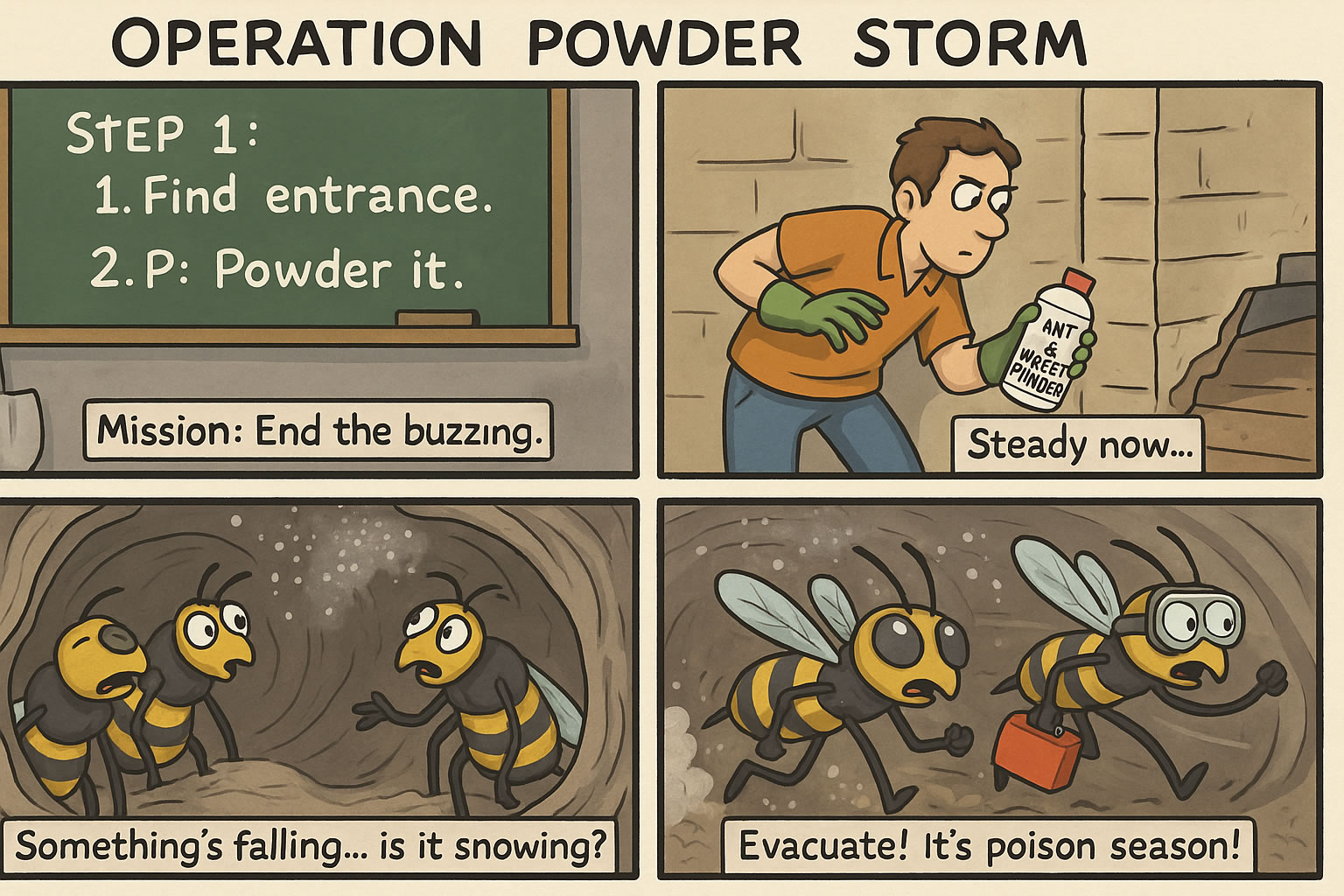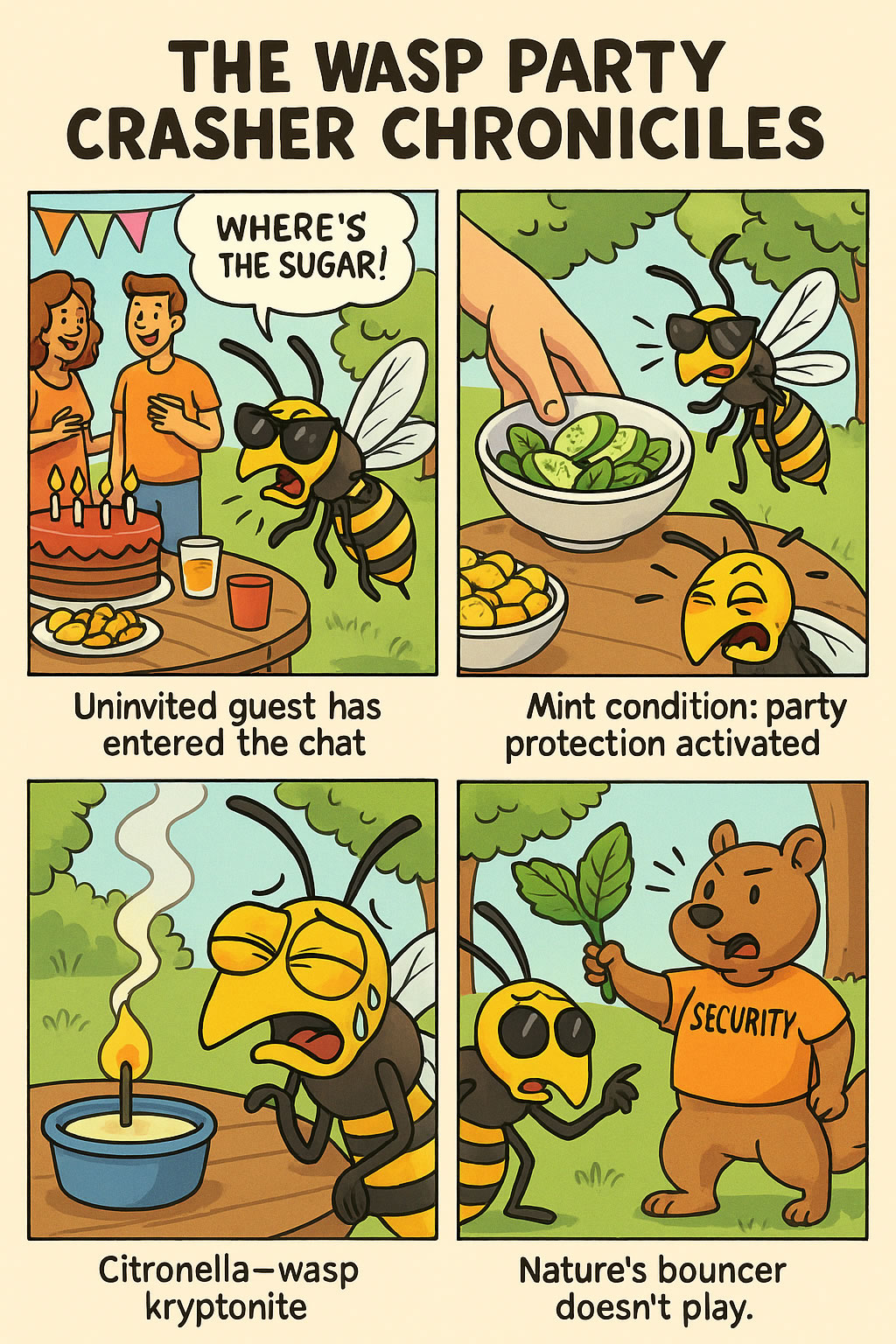Related Queries
ToggleIf you’ve got wasps nesting near your home, you’re probably searching for a quick, safe way to deal with them—without spending a fortune or waiting for a pest control company to arrive. You might have come across ant powder in your cupboard or on shop shelves and wondered—can this actually work on wasps? The short answer is yes, in many cases it can. But it depends on how you use it, and where the nest is.
This guide breaks it down properly—how ant powder works on wasps, how to apply it safely, when it’s a good option (and when it’s not), and what results you can realistically expect.
Can you really use ant powder to kill wasps?
Yes, you can—but only certain types of ant powder will work. Not all of them are suitable, so it’s important to check the active ingredient on the label. You’re looking for a powder that contains permethrin, deltamethrin, or another pyrethroid-based insecticide. These are broad-spectrum insect killers that target the nervous system of insects like ants, wasps, fleas, and more.
Many powders sold for ants are effective against other crawling insects and flying pests too—but only if they say so clearly on the label. If it only lists ants, it may not do much to a wasp colony.
Why would you use ant powder instead of wasp-specific treatments?
There are a few good reasons:
- It’s often cheaper and easier to find
- You might already have it at home
- It works in a similar way to wasp powder
- You can use it when you can’t reach the nest directly
The powder doesn’t need to be puffed deep into the nest—it just needs to sit where the wasps will walk through it. That’s why it works well near nest entrances, cracks, or flight paths.
How does ant powder actually kill wasps?
It works by attacking the wasp’s nervous system. When a wasp walks through the powder, tiny particles cling to its body—especially the legs, wings, and joints. Wasps groom themselves regularly, so the powder gets ingested too. Once inside the body, the active ingredient affects nerve cells and blocks essential signals. That leads to paralysis, then death.
This isn’t always instant. In fact, the delayed effect helps spread the powder further. A single wasp that gets covered in dust might carry it back into the nest, brushing against others and contaminating shared surfaces inside.
Over the next 24–72 hours, the colony starts to weaken as more wasps come into contact with the powder.
Where should you apply the ant powder for best results?
You’re not aiming to destroy the entire nest with one dose—you’re aiming to make as many wasps as possible walk through it. That means focusing on where they enter and exit.
Common spots include:
- A small gap in the wall or roofline
- Air bricks or vents
- The base of a shed or decking
- Cracks in external brickwork
- Around the edge of loft insulation
Once you see a regular flight path—wasps flying in and out of the same hole—you’ve found the entrance. That’s where the powder goes.
You don’t need to get inside the nest. In fact, disturbing it could make things worse. Powder works best when applied calmly, quietly, and precisely.
When is the best time to apply ant powder to a wasp nest?
Go for it either early in the morning or after sunset. That’s when wasps are least active and mostly inside the nest. You’re far less likely to get stung during these times.
Before you apply anything, make sure you’re wearing full clothing that covers your arms, legs, hands and face. Even if you don’t disturb them, wasps can get defensive if they sense movement nearby.
A hoodie, gloves, long trousers and a scarf or veil can give decent short-term protection if you don’t have a bee suit.
Step-by-step: how to use ant powder on a wasp nest
- Identify the entrance
Watch from a distance and find out where they go in and out. You don’t need the whole nest—just the entrance. - Wait until early morning or dusk
You want most wasps inside so the powder gets carried further into the colony. - Dress properly
Cover your skin. Gloves, long sleeves, a scarf, or even protective goggles can reduce sting risk. - Approach quietly and don’t block the hole
Use a plastic spoon or squeeze bottle to apply a light dusting right at the entrance. You want the wasps to walk through it, not avoid it. - Don’t disturb the area after treatment
Walk away calmly and leave the site untouched for at least 48 hours. The powder keeps working over time. - Check for activity after 2–3 days
If you still see lots of wasps, you might need a second dose—or you may have missed a second entrance. - Seal the entrance (only when the nest is dead)
Once you’re sure all wasps are gone, you can seal cracks or holes to stop a new colony forming in the same place.
How long does it take for ant powder to kill a wasp nest?
You might see results within 24 hours, but full activity drop-off can take 2–5 days. The queen is usually the last to go. As long as the powder is still there, it will keep affecting any wasps that touch it.
If they’re still flying in and out after a few days, consider another application. It’s also worth checking the weather forecast—rain can wash powder away.
Can you use ant powder indoors for wasps?
Only with extreme care. Most powders are not suitable for indoor use, especially if there’s airflow or the powder could become airborne.
If the wasps are nesting inside a wall or loft, only treat the outside entry point, not the area above your living space. If you disturb a hidden nest from the inside, the wasps might come into your home.
For indoor nests, it’s usually best to leave it to a pest control expert.
Is ant powder safe for pets and children?
No insecticide is truly safe for pets or young children if misused. Keep everyone away from treated areas for at least 24 hours. Make sure powder doesn’t get tracked inside on shoes or blow back into your house.
Store any leftover product in a sealed container, out of reach.
What are the risks of using ant powder on wasps?
- Getting stung – if you get too close or disturb the nest
- Misidentifying the entrance – powder won’t work if placed in the wrong spot
- Overuse – a thick layer can clog the entrance and make wasps avoid it
- Wind or rain – it can carry the powder away before it works
You need to apply it lightly, accurately, and at the right time. That’s what gets results.
Can you mix ant powder with other methods?
You can—but be careful. Using too many treatments at once can confuse the wasps or cause them to move deeper into the structure.
A good approach is:
- Use powder near the entrance
- Place a wasp trap 10–15 feet away to catch strays
- Block the entrance only after all wasps are gone
Avoid using sprays or foam at the same time as powder. They often cancel each other out.
What if it doesn’t work?
If you’ve tried ant powder and wasps are still active after several days, ask yourself:
- Did you apply it to the correct entrance?
- Was it dry and calm when you applied it?
- Was the powder you used actually suitable for wasps?
- Could the nest have another exit somewhere else?
If the answer is yes to all those, and the wasps are still active, it might be time to bring in a professional. They can use stronger treatments and apply them deeper into the nest safely.
Should you just leave the nest alone instead?
If it’s late in the year (October or later), and the nest isn’t near your living space, you could leave it alone. Wasps don’t survive winter, and they never reuse the same nest twice. Once the cold sets in, the colony will naturally die off.
But if the nest is near children, pets, or heavy foot traffic, it’s safer to act.
Final thoughts – is ant powder a good way to kill wasps?
It can be, as long as:
- The powder is suitable for wasps (check the label)
- You find the right place to apply it
- You wait for the right time and stay safe when applying it
- You allow it time to work without disturbing the nest
It’s not a magic instant fix, but it’s one of the quietest and most cost-effective ways to kill a wasp nest if you do it right.
If you’re unsure, it’s okay to ask a local pest controller for advice. But if you feel confident and follow these steps, using ant powder could be exactly what you need to get rid of that wasp problem—for good.
Pest Control Old Warden – Pest Control How End – Pest Control Slip End













